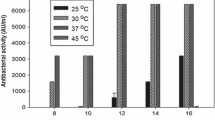Abstract
Data on the dependence of growth characteristics of Lactococcus lactis subsp. lactis 729 and TB2 extracted from milk and homemade curd on the content of casein peptone (CP) as the main source of nitrogen in the agar medium is presented. The number of colony-forming units (CFUs), cell division rate (CDR), and mean hourly doubling time (HDT) were compared between two time segments of cultivation: from 1 to 2.5 h, and from 2.5 to 3.5 h. In liquid media, logarithmic growth was observed for the 729 strain in all groups for 3.5 h at minimal pH of 6.5. The maximum biomass production rate (2.5 × 108 cells/mL) was observed in the media containing the meat extract; the minimal HDT was in the biomass transferred from the minimal MA4 medium to the enriched M7 medium. In contrast with the TB2 strain, the 729 strain does not form colonies on agar media at CP concentrations below 0.4%. The colonies of the TB2 strain increase in size from 2.85 mm2 to 5 mm2 when decreasing CP concentration from 1 to 0.4%. The yeast extract has a stimulating effect in liquid media at said concentration ratios, leading to an increase in the efficiency of cell division at lower rates of lactic acid production, to pH of 5.5 when oligopeptide transport is blocked. The meat extract provides adaptation of bacteria to the conditions of excessive acidity and has positive effect on cell division in the 729 strain at later stages of bacterial colony development. The smaller size of colonies of the strain might be evidence of active acid formation.
Similar content being viewed by others
References
Praktikum po mikrobiologii (A Practical Course in Microbiology), Netrusov, A.I., Ed., Moscow: ACADEMA, 2005, Ch. 44, pp. 467–478.
Duwat, P., Cesselin, B., Sourice, S., and Gruss, A., Lactococcus lactis, a bacterial model for stress responses and survival, Int. J. Food Microbiol., 2000, vol. 55, pp. 83–86.
Hartke, A., Boucheacute, S., Giard, J.C., Benachour, A., Boutibonnes, P., and Auffray, Y., The lactic acid stress response of Lactococcus lactis subsp. lactis, Curr. Microbiol., 1996, vol. 33, no. 3, pp. 194–199.
Trenina, M.A., Lysenko, A.M., Akhverdyan, V.Z., and Mchedlishvili, E.B., Study of intraspecific variations of the bacterium Lactococcus lactis in adaptation to high acidity of the medium, Microbiology (Moscow), 2006, vol. 75, no. 1, pp. 97–104.
Stoyanova, L.G., Sul’timova, T.D., and Netrusov, A.I., Effect of phosphate and carbohydrates on the synthesis of nisin by Lactococcus lactis subsp. lactis strain 194, Vestn. Mosk. Univ., Ser. Biol., 2003, no. 4, pp. 17–22.
Stoyanova, L.G. and Levina, N.A., Components of fermentation medium regulate bacteriocin synthesis by the recombinant strain Lactococcus lactis subsp. lactis F-116, Microbiology (Moscow), 2006, vol. 75, no. 3, pp. 286–291.
Huggins, A.R. and Sandine, W.E., Differentiation of fast and slow milk-coagulating isolates in strains of lactic streptococci, J. Dairy Sci., 1984, vol. 67, pp. 1674–1679.
Sukhodolets, V.V., Lysenko, A.M., and Trenina, M.A., RF Patent No. 2244002, 2003.
Corroler, D., Mangin, I., Desmasures, N., and Gueguen, M., An ecological study of lactococci isolated from raw milk in the camembert cheese registered designation of origin area, Appl. Environ. Microbiol., 1998, vol. 64, no. 12, pp. 4729–4735.
Mills, S., McAuliffe, O.E., Coffey, A., Fitzgerald, G.F., and Ross, R.P., Plasmids of lactococci—genetic accessories or genetic necessities?, FEMS Microbiol. Rev., 2006, vol. 30, pp. 243–273.
Kelly, W. and Ward, L., Genotypic vs. phenotypic biodiversity in Lactococcus lactis, Microbiology, 2002, vol. 148, pp. 3332–3333.
Stoyanova, L.G. and Egorov, N.S., Derivation of efficient nisin producers by fusing protoplasts of two allied strains of Lactococcus lactis subsp. lactis with low nisinsynthesizing abilities, Microbiology (Moscow), 1998, vol. 67, no. 1, pp. 38–44.
Stoyanova, L.G., Sul’timova, T.D., and Netrusov, A.I., Establishment of taxonomic status of new prospective bacteriocin-synthesizing Lactococci strains of various origins, Moscow Univ. Biol. Bull., 2008, vol. 62, no. 4, pp. 156–162.
Trenina, M.A., Ganina, V.I., Stoyanova, L.G., Rybakov, Yu.A., and Skladnev, D.A., Characteristics of development of lactic acid bacteria Lactococcus lactis subs. lactis strain 729, Pererab. Sel’skokhoz. Syr’ya, 2008, no. 8, pp. 55–57.
Trenina, M.A., Skladnev, D.A., Bronnikov, S.V., Ustyugova, E.A., and Stoyanova, L.G., Development of populations of bacteria Lactococcus lactis ssp. lactis on agar nutrient media simulating the natural substrate, Ekol. Prom. Ross., 2009, no. 5, pp. 42–46.
Hutkins, R.W. and Nannen, N.L., pH homeostasis in lactic acid bacteria, J. Dairy Sci., 1993, vol. 76, pp. 2354–2365.
Frees, D., Vogensen, F.K., and Ingmer, H., Identification of proteins induced at low pH in Lactococcus lactis, Int. J. Food Microbiol., 2003, no. 87, pp. 293–300.
Foucaud, C. and Juillard, V., Accumulation of caseinderived peptides during growth of proteinase-positive strains of Lactococcus lactis in milk: their contribution to subsequent bacterial growth is impaired by their internal transport, J. Dairy Res., 2000, vol. 67, pp. 233–240.
Juillard, V., Le Bars, D., Kunji, E.R.S., Konings, W.N., Gripon, J.-C., Richard, J., Oligopeptides are the main source of nitrogen for Lactococcus lactis during growth in milk, Appl. Environ. Microbiol., 1995, vol. 61, pp. 3024–3030.
Letort, C., Nardi, M., Garault, P., Monnet, V., and Juillard, V., Casein utilization by Streptococcus thermophilus results in a diauxic growth in milk, Appl. Environ. Microbiol., 2002, vol. 68, no. 6, pp. 3162–3165.
Author information
Authors and Affiliations
Corresponding author
Additional information
Original Russian Text © M.A. Trenina, A.S. Yepremyan, L.G. Stoyanova, 2015, published in Vestnik Moskovskogo Universiteta. Biologiya, 2015, No. 1, pp. 31–36.
About this article
Cite this article
Trenina, M.A., Yepremyan, A.S. & Stoyanova, L.G. Dependence of growth characteristics of original strains of Lactococcus lactis subsp. lactis on the composition of agar media used for biomass growth. Moscow Univ. Biol.Sci. Bull. 70, 29–34 (2015). https://doi.org/10.3103/S0096392515010095
Received:
Published:
Issue Date:
DOI: https://doi.org/10.3103/S0096392515010095




